Business Research Report: Challenges in Cyber Security for Enterprises
VerifiedAdded on 2021/05/31
|14
|3395
|193
Report
AI Summary
This report provides a comprehensive analysis of the challenges faced by businesses in the realm of cyber security. It begins by highlighting the increasing importance of cyber security due to the rise of cyber-attacks and data breaches in the modern business landscape. The report then delves into the various challenges, including lack of investment in cyber security, lack of awareness among organizations, and the increasing threats posed by smartphones, social media, ransomware, and other forms of cyber-attacks. The report also examines the impact of hacktivism and the growing threat of mobile malware. Furthermore, it provides recommendations for businesses to improve their cyber security posture, such as prioritizing cyber security requirements, providing employee training, enhancing physical security of data and computer systems, implementing data encryption, and investing in firewalls and anti-virus software. The report concludes by emphasizing the need for proactive measures to protect businesses from the ever-evolving cyber threats.
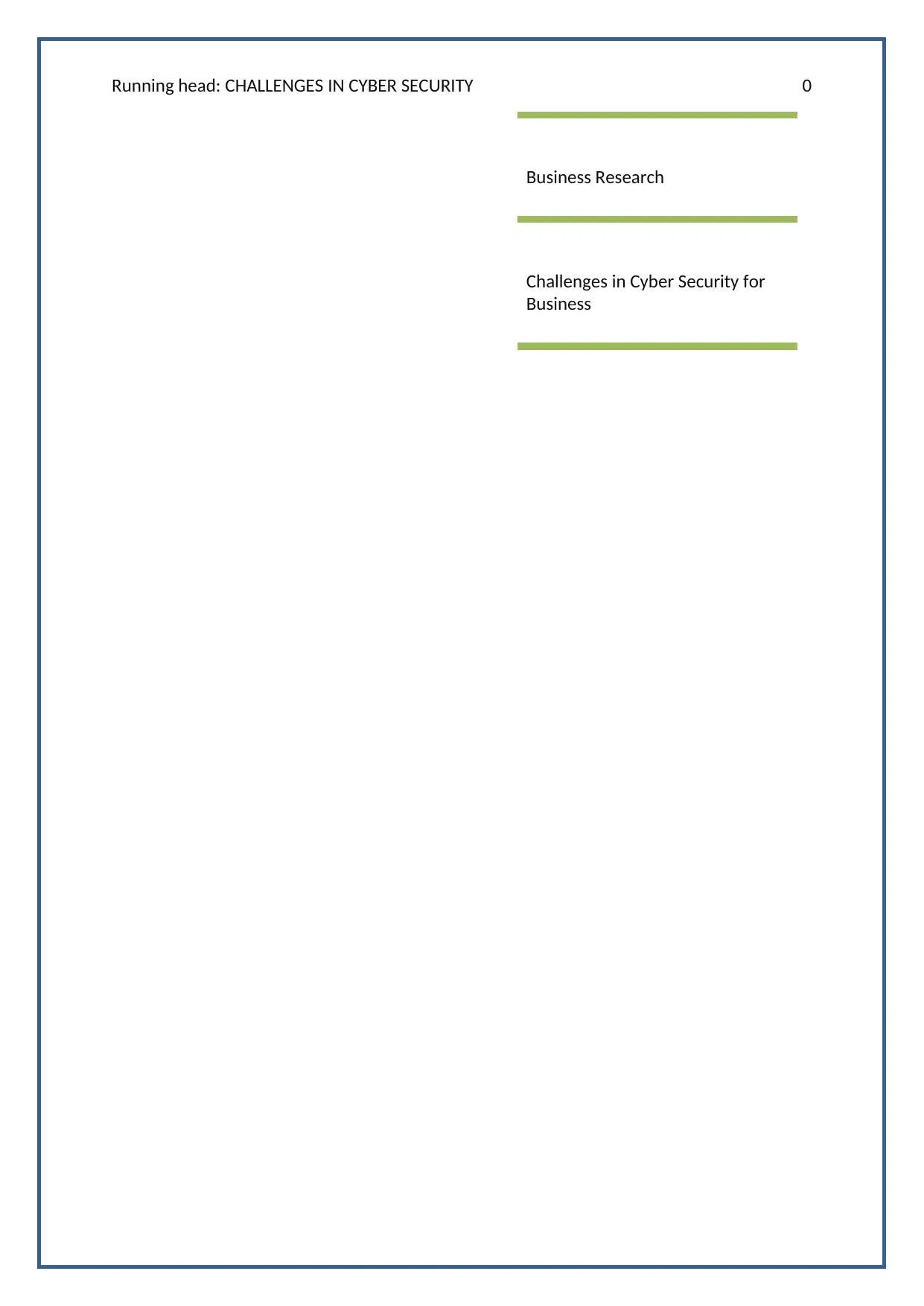
Running head: CHALLENGES IN CYBER SECURITY 0
Business Research
Challenges in Cyber Security for
Business
Business Research
Challenges in Cyber Security for
Business
Paraphrase This Document
Need a fresh take? Get an instant paraphrase of this document with our AI Paraphraser
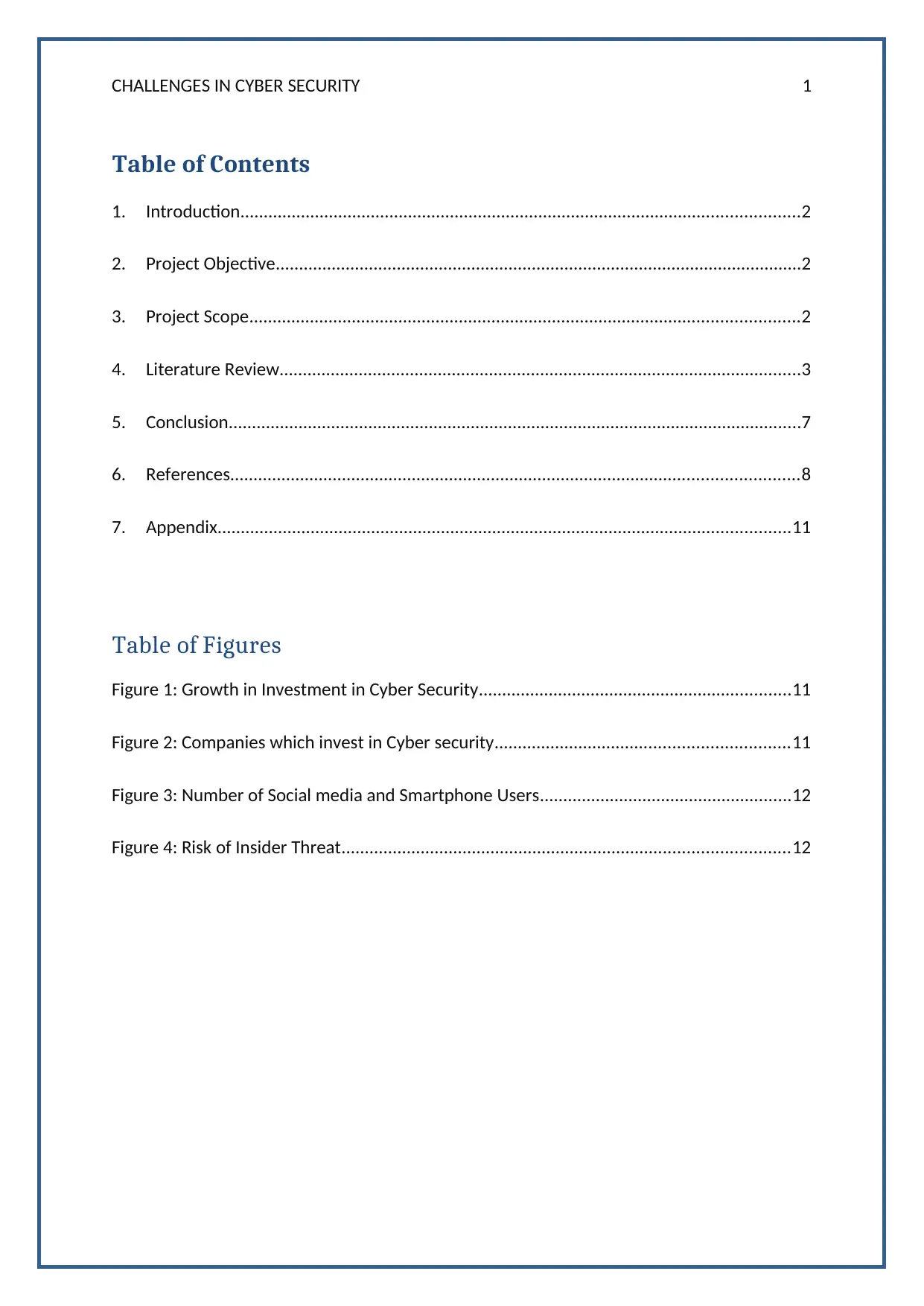
CHALLENGES IN CYBER SECURITY 1
Table of Contents
1. Introduction........................................................................................................................2
2. Project Objective.................................................................................................................2
3. Project Scope......................................................................................................................2
4. Literature Review................................................................................................................3
5. Conclusion...........................................................................................................................7
6. References..........................................................................................................................8
7. Appendix...........................................................................................................................11
Table of Figures
Figure 1: Growth in Investment in Cyber Security...................................................................11
Figure 2: Companies which invest in Cyber security...............................................................11
Figure 3: Number of Social media and Smartphone Users......................................................12
Figure 4: Risk of Insider Threat................................................................................................12
Table of Contents
1. Introduction........................................................................................................................2
2. Project Objective.................................................................................................................2
3. Project Scope......................................................................................................................2
4. Literature Review................................................................................................................3
5. Conclusion...........................................................................................................................7
6. References..........................................................................................................................8
7. Appendix...........................................................................................................................11
Table of Figures
Figure 1: Growth in Investment in Cyber Security...................................................................11
Figure 2: Companies which invest in Cyber security...............................................................11
Figure 3: Number of Social media and Smartphone Users......................................................12
Figure 4: Risk of Insider Threat................................................................................................12
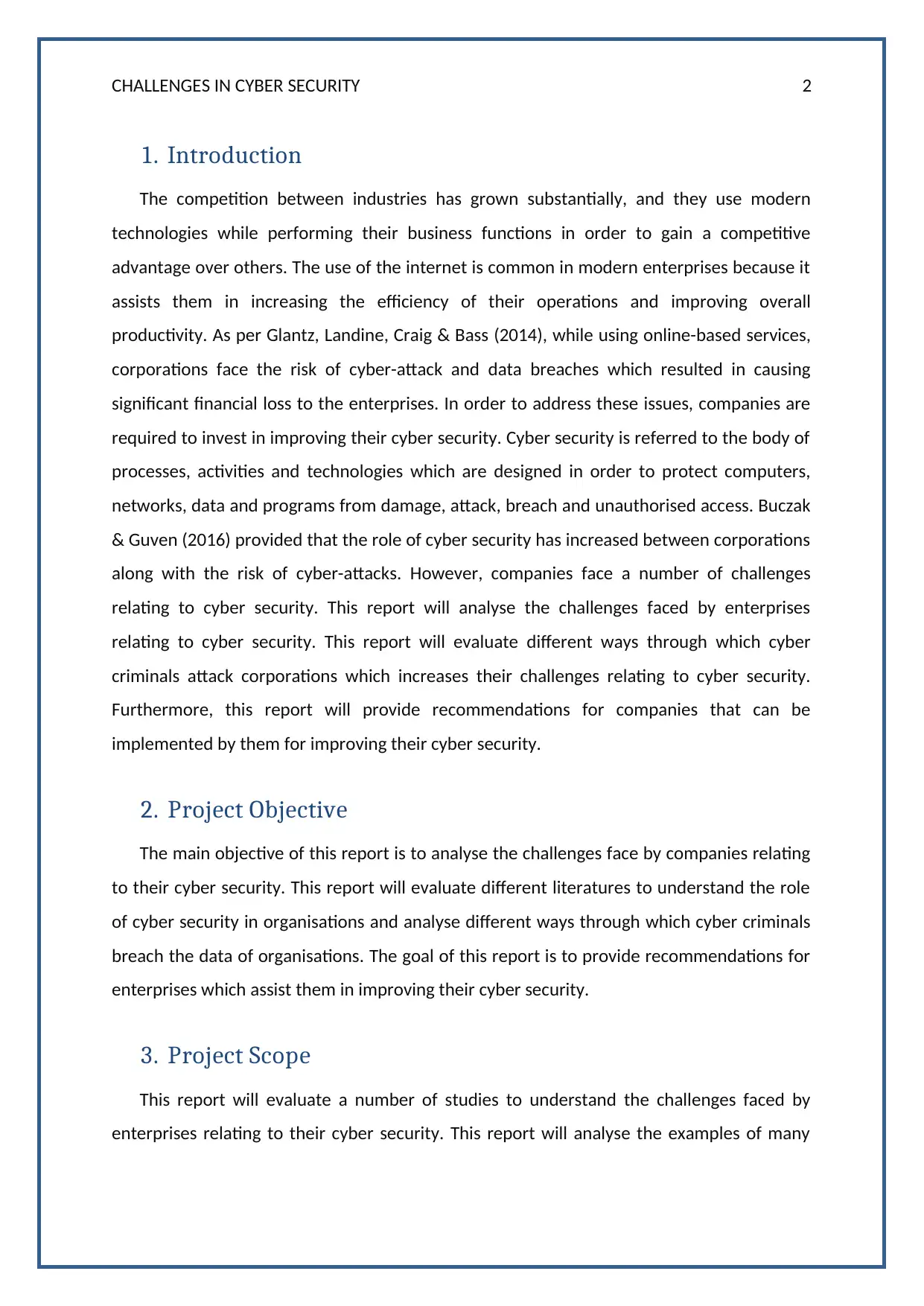
CHALLENGES IN CYBER SECURITY 2
1. Introduction
The competition between industries has grown substantially, and they use modern
technologies while performing their business functions in order to gain a competitive
advantage over others. The use of the internet is common in modern enterprises because it
assists them in increasing the efficiency of their operations and improving overall
productivity. As per Glantz, Landine, Craig & Bass (2014), while using online-based services,
corporations face the risk of cyber-attack and data breaches which resulted in causing
significant financial loss to the enterprises. In order to address these issues, companies are
required to invest in improving their cyber security. Cyber security is referred to the body of
processes, activities and technologies which are designed in order to protect computers,
networks, data and programs from damage, attack, breach and unauthorised access. Buczak
& Guven (2016) provided that the role of cyber security has increased between corporations
along with the risk of cyber-attacks. However, companies face a number of challenges
relating to cyber security. This report will analyse the challenges faced by enterprises
relating to cyber security. This report will evaluate different ways through which cyber
criminals attack corporations which increases their challenges relating to cyber security.
Furthermore, this report will provide recommendations for companies that can be
implemented by them for improving their cyber security.
2. Project Objective
The main objective of this report is to analyse the challenges face by companies relating
to their cyber security. This report will evaluate different literatures to understand the role
of cyber security in organisations and analyse different ways through which cyber criminals
breach the data of organisations. The goal of this report is to provide recommendations for
enterprises which assist them in improving their cyber security.
3. Project Scope
This report will evaluate a number of studies to understand the challenges faced by
enterprises relating to their cyber security. This report will analyse the examples of many
1. Introduction
The competition between industries has grown substantially, and they use modern
technologies while performing their business functions in order to gain a competitive
advantage over others. The use of the internet is common in modern enterprises because it
assists them in increasing the efficiency of their operations and improving overall
productivity. As per Glantz, Landine, Craig & Bass (2014), while using online-based services,
corporations face the risk of cyber-attack and data breaches which resulted in causing
significant financial loss to the enterprises. In order to address these issues, companies are
required to invest in improving their cyber security. Cyber security is referred to the body of
processes, activities and technologies which are designed in order to protect computers,
networks, data and programs from damage, attack, breach and unauthorised access. Buczak
& Guven (2016) provided that the role of cyber security has increased between corporations
along with the risk of cyber-attacks. However, companies face a number of challenges
relating to cyber security. This report will analyse the challenges faced by enterprises
relating to cyber security. This report will evaluate different ways through which cyber
criminals attack corporations which increases their challenges relating to cyber security.
Furthermore, this report will provide recommendations for companies that can be
implemented by them for improving their cyber security.
2. Project Objective
The main objective of this report is to analyse the challenges face by companies relating
to their cyber security. This report will evaluate different literatures to understand the role
of cyber security in organisations and analyse different ways through which cyber criminals
breach the data of organisations. The goal of this report is to provide recommendations for
enterprises which assist them in improving their cyber security.
3. Project Scope
This report will evaluate a number of studies to understand the challenges faced by
enterprises relating to their cyber security. This report will analyse the examples of many
⊘ This is a preview!⊘
Do you want full access?
Subscribe today to unlock all pages.

Trusted by 1+ million students worldwide
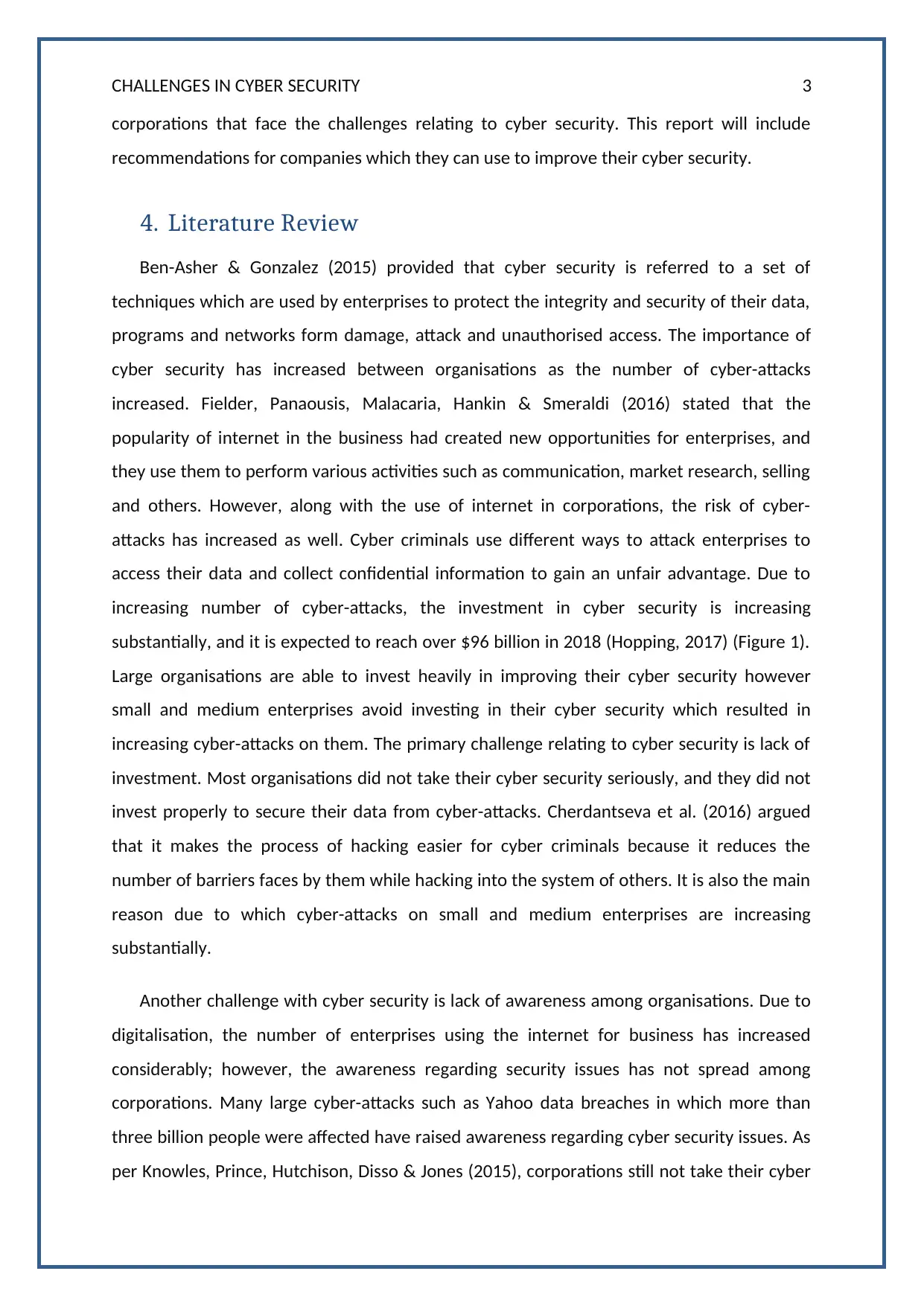
CHALLENGES IN CYBER SECURITY 3
corporations that face the challenges relating to cyber security. This report will include
recommendations for companies which they can use to improve their cyber security.
4. Literature Review
Ben-Asher & Gonzalez (2015) provided that cyber security is referred to a set of
techniques which are used by enterprises to protect the integrity and security of their data,
programs and networks form damage, attack and unauthorised access. The importance of
cyber security has increased between organisations as the number of cyber-attacks
increased. Fielder, Panaousis, Malacaria, Hankin & Smeraldi (2016) stated that the
popularity of internet in the business had created new opportunities for enterprises, and
they use them to perform various activities such as communication, market research, selling
and others. However, along with the use of internet in corporations, the risk of cyber-
attacks has increased as well. Cyber criminals use different ways to attack enterprises to
access their data and collect confidential information to gain an unfair advantage. Due to
increasing number of cyber-attacks, the investment in cyber security is increasing
substantially, and it is expected to reach over $96 billion in 2018 (Hopping, 2017) (Figure 1).
Large organisations are able to invest heavily in improving their cyber security however
small and medium enterprises avoid investing in their cyber security which resulted in
increasing cyber-attacks on them. The primary challenge relating to cyber security is lack of
investment. Most organisations did not take their cyber security seriously, and they did not
invest properly to secure their data from cyber-attacks. Cherdantseva et al. (2016) argued
that it makes the process of hacking easier for cyber criminals because it reduces the
number of barriers faces by them while hacking into the system of others. It is also the main
reason due to which cyber-attacks on small and medium enterprises are increasing
substantially.
Another challenge with cyber security is lack of awareness among organisations. Due to
digitalisation, the number of enterprises using the internet for business has increased
considerably; however, the awareness regarding security issues has not spread among
corporations. Many large cyber-attacks such as Yahoo data breaches in which more than
three billion people were affected have raised awareness regarding cyber security issues. As
per Knowles, Prince, Hutchison, Disso & Jones (2015), corporations still not take their cyber
corporations that face the challenges relating to cyber security. This report will include
recommendations for companies which they can use to improve their cyber security.
4. Literature Review
Ben-Asher & Gonzalez (2015) provided that cyber security is referred to a set of
techniques which are used by enterprises to protect the integrity and security of their data,
programs and networks form damage, attack and unauthorised access. The importance of
cyber security has increased between organisations as the number of cyber-attacks
increased. Fielder, Panaousis, Malacaria, Hankin & Smeraldi (2016) stated that the
popularity of internet in the business had created new opportunities for enterprises, and
they use them to perform various activities such as communication, market research, selling
and others. However, along with the use of internet in corporations, the risk of cyber-
attacks has increased as well. Cyber criminals use different ways to attack enterprises to
access their data and collect confidential information to gain an unfair advantage. Due to
increasing number of cyber-attacks, the investment in cyber security is increasing
substantially, and it is expected to reach over $96 billion in 2018 (Hopping, 2017) (Figure 1).
Large organisations are able to invest heavily in improving their cyber security however
small and medium enterprises avoid investing in their cyber security which resulted in
increasing cyber-attacks on them. The primary challenge relating to cyber security is lack of
investment. Most organisations did not take their cyber security seriously, and they did not
invest properly to secure their data from cyber-attacks. Cherdantseva et al. (2016) argued
that it makes the process of hacking easier for cyber criminals because it reduces the
number of barriers faces by them while hacking into the system of others. It is also the main
reason due to which cyber-attacks on small and medium enterprises are increasing
substantially.
Another challenge with cyber security is lack of awareness among organisations. Due to
digitalisation, the number of enterprises using the internet for business has increased
considerably; however, the awareness regarding security issues has not spread among
corporations. Many large cyber-attacks such as Yahoo data breaches in which more than
three billion people were affected have raised awareness regarding cyber security issues. As
per Knowles, Prince, Hutchison, Disso & Jones (2015), corporations still not take their cyber
Paraphrase This Document
Need a fresh take? Get an instant paraphrase of this document with our AI Paraphraser
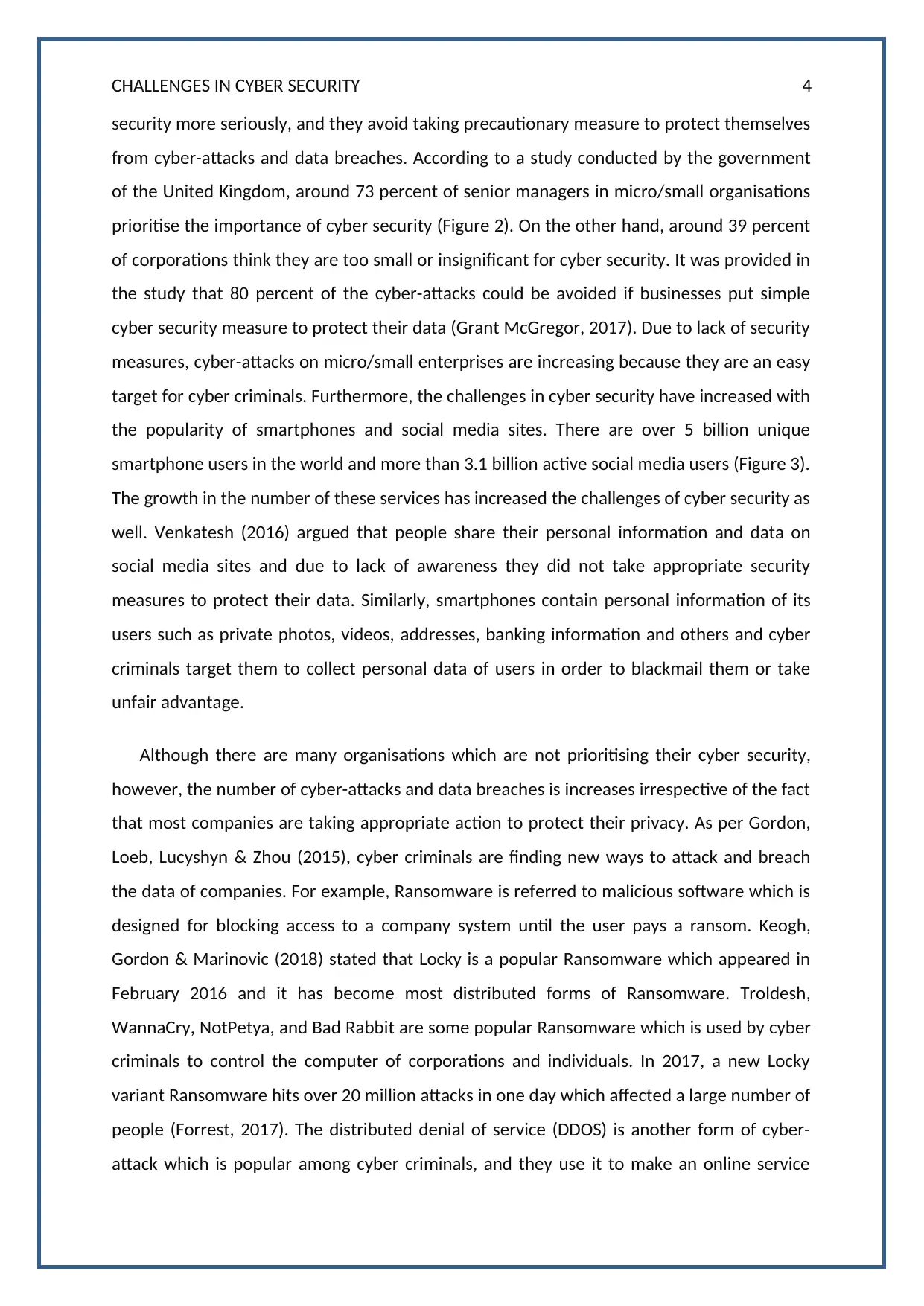
CHALLENGES IN CYBER SECURITY 4
security more seriously, and they avoid taking precautionary measure to protect themselves
from cyber-attacks and data breaches. According to a study conducted by the government
of the United Kingdom, around 73 percent of senior managers in micro/small organisations
prioritise the importance of cyber security (Figure 2). On the other hand, around 39 percent
of corporations think they are too small or insignificant for cyber security. It was provided in
the study that 80 percent of the cyber-attacks could be avoided if businesses put simple
cyber security measure to protect their data (Grant McGregor, 2017). Due to lack of security
measures, cyber-attacks on micro/small enterprises are increasing because they are an easy
target for cyber criminals. Furthermore, the challenges in cyber security have increased with
the popularity of smartphones and social media sites. There are over 5 billion unique
smartphone users in the world and more than 3.1 billion active social media users (Figure 3).
The growth in the number of these services has increased the challenges of cyber security as
well. Venkatesh (2016) argued that people share their personal information and data on
social media sites and due to lack of awareness they did not take appropriate security
measures to protect their data. Similarly, smartphones contain personal information of its
users such as private photos, videos, addresses, banking information and others and cyber
criminals target them to collect personal data of users in order to blackmail them or take
unfair advantage.
Although there are many organisations which are not prioritising their cyber security,
however, the number of cyber-attacks and data breaches is increases irrespective of the fact
that most companies are taking appropriate action to protect their privacy. As per Gordon,
Loeb, Lucyshyn & Zhou (2015), cyber criminals are finding new ways to attack and breach
the data of companies. For example, Ransomware is referred to malicious software which is
designed for blocking access to a company system until the user pays a ransom. Keogh,
Gordon & Marinovic (2018) stated that Locky is a popular Ransomware which appeared in
February 2016 and it has become most distributed forms of Ransomware. Troldesh,
WannaCry, NotPetya, and Bad Rabbit are some popular Ransomware which is used by cyber
criminals to control the computer of corporations and individuals. In 2017, a new Locky
variant Ransomware hits over 20 million attacks in one day which affected a large number of
people (Forrest, 2017). The distributed denial of service (DDOS) is another form of cyber-
attack which is popular among cyber criminals, and they use it to make an online service
security more seriously, and they avoid taking precautionary measure to protect themselves
from cyber-attacks and data breaches. According to a study conducted by the government
of the United Kingdom, around 73 percent of senior managers in micro/small organisations
prioritise the importance of cyber security (Figure 2). On the other hand, around 39 percent
of corporations think they are too small or insignificant for cyber security. It was provided in
the study that 80 percent of the cyber-attacks could be avoided if businesses put simple
cyber security measure to protect their data (Grant McGregor, 2017). Due to lack of security
measures, cyber-attacks on micro/small enterprises are increasing because they are an easy
target for cyber criminals. Furthermore, the challenges in cyber security have increased with
the popularity of smartphones and social media sites. There are over 5 billion unique
smartphone users in the world and more than 3.1 billion active social media users (Figure 3).
The growth in the number of these services has increased the challenges of cyber security as
well. Venkatesh (2016) argued that people share their personal information and data on
social media sites and due to lack of awareness they did not take appropriate security
measures to protect their data. Similarly, smartphones contain personal information of its
users such as private photos, videos, addresses, banking information and others and cyber
criminals target them to collect personal data of users in order to blackmail them or take
unfair advantage.
Although there are many organisations which are not prioritising their cyber security,
however, the number of cyber-attacks and data breaches is increases irrespective of the fact
that most companies are taking appropriate action to protect their privacy. As per Gordon,
Loeb, Lucyshyn & Zhou (2015), cyber criminals are finding new ways to attack and breach
the data of companies. For example, Ransomware is referred to malicious software which is
designed for blocking access to a company system until the user pays a ransom. Keogh,
Gordon & Marinovic (2018) stated that Locky is a popular Ransomware which appeared in
February 2016 and it has become most distributed forms of Ransomware. Troldesh,
WannaCry, NotPetya, and Bad Rabbit are some popular Ransomware which is used by cyber
criminals to control the computer of corporations and individuals. In 2017, a new Locky
variant Ransomware hits over 20 million attacks in one day which affected a large number of
people (Forrest, 2017). The distributed denial of service (DDOS) is another form of cyber-
attack which is popular among cyber criminals, and they use it to make an online service
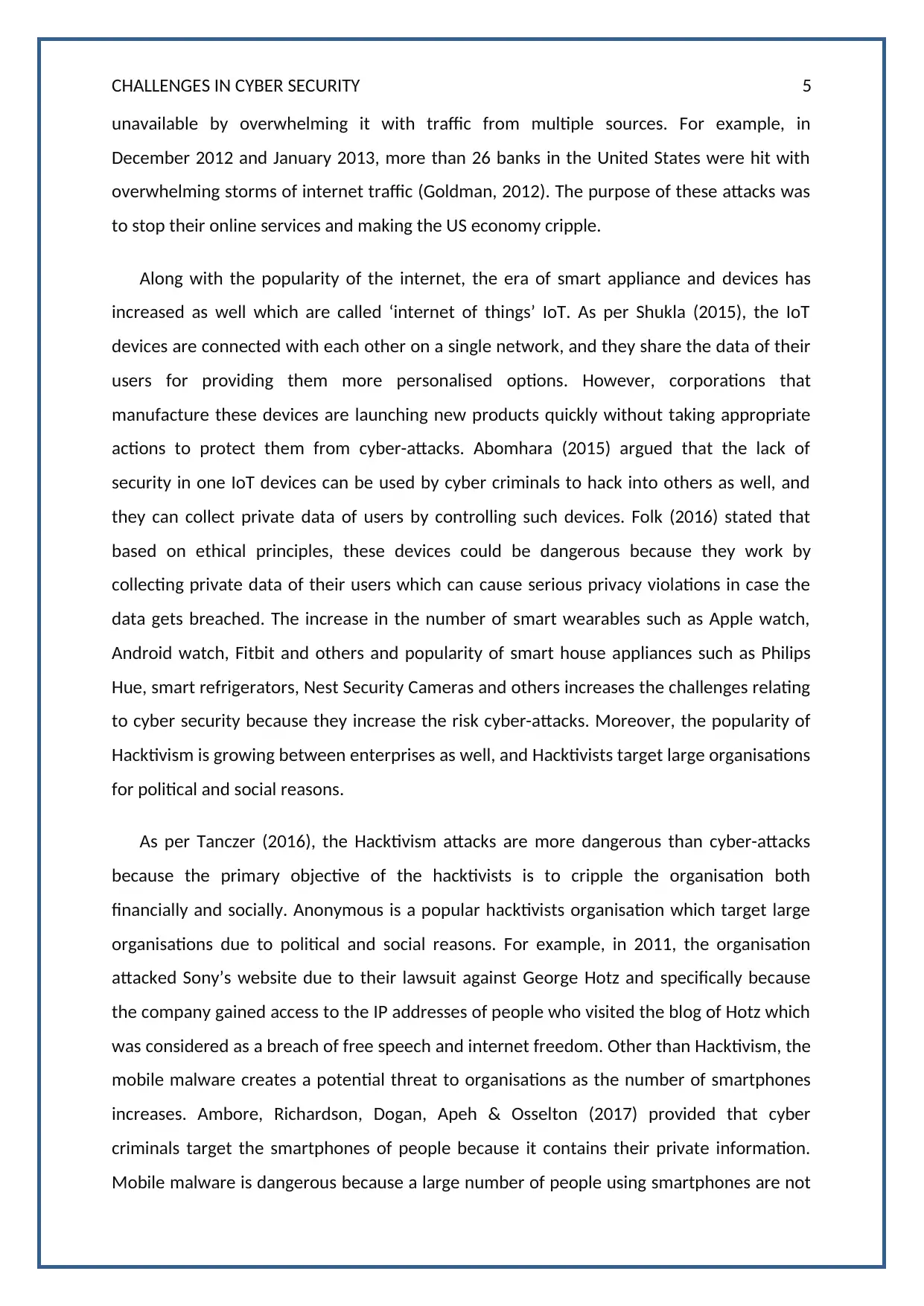
CHALLENGES IN CYBER SECURITY 5
unavailable by overwhelming it with traffic from multiple sources. For example, in
December 2012 and January 2013, more than 26 banks in the United States were hit with
overwhelming storms of internet traffic (Goldman, 2012). The purpose of these attacks was
to stop their online services and making the US economy cripple.
Along with the popularity of the internet, the era of smart appliance and devices has
increased as well which are called ‘internet of things’ IoT. As per Shukla (2015), the IoT
devices are connected with each other on a single network, and they share the data of their
users for providing them more personalised options. However, corporations that
manufacture these devices are launching new products quickly without taking appropriate
actions to protect them from cyber-attacks. Abomhara (2015) argued that the lack of
security in one IoT devices can be used by cyber criminals to hack into others as well, and
they can collect private data of users by controlling such devices. Folk (2016) stated that
based on ethical principles, these devices could be dangerous because they work by
collecting private data of their users which can cause serious privacy violations in case the
data gets breached. The increase in the number of smart wearables such as Apple watch,
Android watch, Fitbit and others and popularity of smart house appliances such as Philips
Hue, smart refrigerators, Nest Security Cameras and others increases the challenges relating
to cyber security because they increase the risk cyber-attacks. Moreover, the popularity of
Hacktivism is growing between enterprises as well, and Hacktivists target large organisations
for political and social reasons.
As per Tanczer (2016), the Hacktivism attacks are more dangerous than cyber-attacks
because the primary objective of the hacktivists is to cripple the organisation both
financially and socially. Anonymous is a popular hacktivists organisation which target large
organisations due to political and social reasons. For example, in 2011, the organisation
attacked Sony’s website due to their lawsuit against George Hotz and specifically because
the company gained access to the IP addresses of people who visited the blog of Hotz which
was considered as a breach of free speech and internet freedom. Other than Hacktivism, the
mobile malware creates a potential threat to organisations as the number of smartphones
increases. Ambore, Richardson, Dogan, Apeh & Osselton (2017) provided that cyber
criminals target the smartphones of people because it contains their private information.
Mobile malware is dangerous because a large number of people using smartphones are not
unavailable by overwhelming it with traffic from multiple sources. For example, in
December 2012 and January 2013, more than 26 banks in the United States were hit with
overwhelming storms of internet traffic (Goldman, 2012). The purpose of these attacks was
to stop their online services and making the US economy cripple.
Along with the popularity of the internet, the era of smart appliance and devices has
increased as well which are called ‘internet of things’ IoT. As per Shukla (2015), the IoT
devices are connected with each other on a single network, and they share the data of their
users for providing them more personalised options. However, corporations that
manufacture these devices are launching new products quickly without taking appropriate
actions to protect them from cyber-attacks. Abomhara (2015) argued that the lack of
security in one IoT devices can be used by cyber criminals to hack into others as well, and
they can collect private data of users by controlling such devices. Folk (2016) stated that
based on ethical principles, these devices could be dangerous because they work by
collecting private data of their users which can cause serious privacy violations in case the
data gets breached. The increase in the number of smart wearables such as Apple watch,
Android watch, Fitbit and others and popularity of smart house appliances such as Philips
Hue, smart refrigerators, Nest Security Cameras and others increases the challenges relating
to cyber security because they increase the risk cyber-attacks. Moreover, the popularity of
Hacktivism is growing between enterprises as well, and Hacktivists target large organisations
for political and social reasons.
As per Tanczer (2016), the Hacktivism attacks are more dangerous than cyber-attacks
because the primary objective of the hacktivists is to cripple the organisation both
financially and socially. Anonymous is a popular hacktivists organisation which target large
organisations due to political and social reasons. For example, in 2011, the organisation
attacked Sony’s website due to their lawsuit against George Hotz and specifically because
the company gained access to the IP addresses of people who visited the blog of Hotz which
was considered as a breach of free speech and internet freedom. Other than Hacktivism, the
mobile malware creates a potential threat to organisations as the number of smartphones
increases. Ambore, Richardson, Dogan, Apeh & Osselton (2017) provided that cyber
criminals target the smartphones of people because it contains their private information.
Mobile malware is dangerous because a large number of people using smartphones are not
⊘ This is a preview!⊘
Do you want full access?
Subscribe today to unlock all pages.

Trusted by 1+ million students worldwide
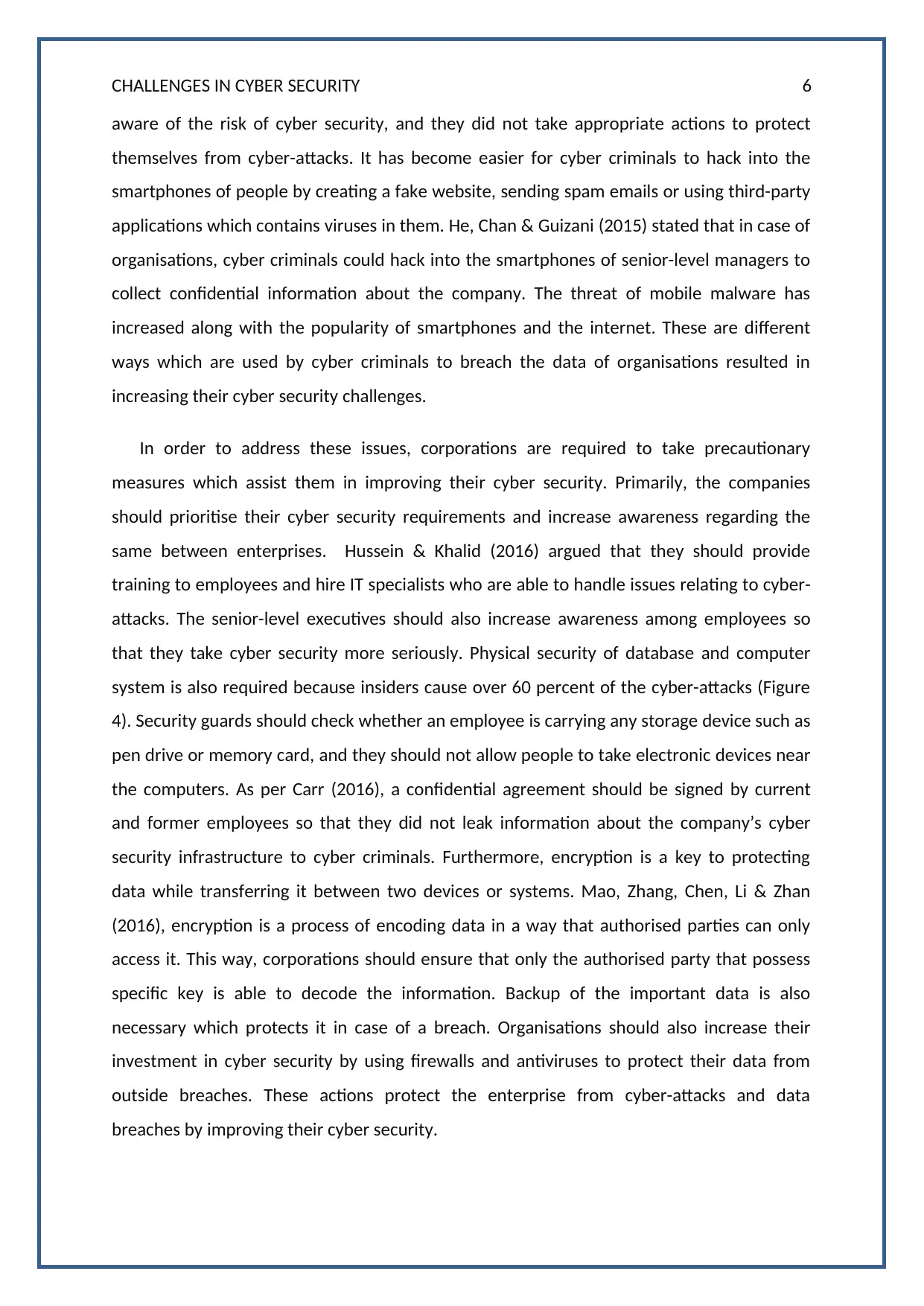
CHALLENGES IN CYBER SECURITY 6
aware of the risk of cyber security, and they did not take appropriate actions to protect
themselves from cyber-attacks. It has become easier for cyber criminals to hack into the
smartphones of people by creating a fake website, sending spam emails or using third-party
applications which contains viruses in them. He, Chan & Guizani (2015) stated that in case of
organisations, cyber criminals could hack into the smartphones of senior-level managers to
collect confidential information about the company. The threat of mobile malware has
increased along with the popularity of smartphones and the internet. These are different
ways which are used by cyber criminals to breach the data of organisations resulted in
increasing their cyber security challenges.
In order to address these issues, corporations are required to take precautionary
measures which assist them in improving their cyber security. Primarily, the companies
should prioritise their cyber security requirements and increase awareness regarding the
same between enterprises. Hussein & Khalid (2016) argued that they should provide
training to employees and hire IT specialists who are able to handle issues relating to cyber-
attacks. The senior-level executives should also increase awareness among employees so
that they take cyber security more seriously. Physical security of database and computer
system is also required because insiders cause over 60 percent of the cyber-attacks (Figure
4). Security guards should check whether an employee is carrying any storage device such as
pen drive or memory card, and they should not allow people to take electronic devices near
the computers. As per Carr (2016), a confidential agreement should be signed by current
and former employees so that they did not leak information about the company’s cyber
security infrastructure to cyber criminals. Furthermore, encryption is a key to protecting
data while transferring it between two devices or systems. Mao, Zhang, Chen, Li & Zhan
(2016), encryption is a process of encoding data in a way that authorised parties can only
access it. This way, corporations should ensure that only the authorised party that possess
specific key is able to decode the information. Backup of the important data is also
necessary which protects it in case of a breach. Organisations should also increase their
investment in cyber security by using firewalls and antiviruses to protect their data from
outside breaches. These actions protect the enterprise from cyber-attacks and data
breaches by improving their cyber security.
aware of the risk of cyber security, and they did not take appropriate actions to protect
themselves from cyber-attacks. It has become easier for cyber criminals to hack into the
smartphones of people by creating a fake website, sending spam emails or using third-party
applications which contains viruses in them. He, Chan & Guizani (2015) stated that in case of
organisations, cyber criminals could hack into the smartphones of senior-level managers to
collect confidential information about the company. The threat of mobile malware has
increased along with the popularity of smartphones and the internet. These are different
ways which are used by cyber criminals to breach the data of organisations resulted in
increasing their cyber security challenges.
In order to address these issues, corporations are required to take precautionary
measures which assist them in improving their cyber security. Primarily, the companies
should prioritise their cyber security requirements and increase awareness regarding the
same between enterprises. Hussein & Khalid (2016) argued that they should provide
training to employees and hire IT specialists who are able to handle issues relating to cyber-
attacks. The senior-level executives should also increase awareness among employees so
that they take cyber security more seriously. Physical security of database and computer
system is also required because insiders cause over 60 percent of the cyber-attacks (Figure
4). Security guards should check whether an employee is carrying any storage device such as
pen drive or memory card, and they should not allow people to take electronic devices near
the computers. As per Carr (2016), a confidential agreement should be signed by current
and former employees so that they did not leak information about the company’s cyber
security infrastructure to cyber criminals. Furthermore, encryption is a key to protecting
data while transferring it between two devices or systems. Mao, Zhang, Chen, Li & Zhan
(2016), encryption is a process of encoding data in a way that authorised parties can only
access it. This way, corporations should ensure that only the authorised party that possess
specific key is able to decode the information. Backup of the important data is also
necessary which protects it in case of a breach. Organisations should also increase their
investment in cyber security by using firewalls and antiviruses to protect their data from
outside breaches. These actions protect the enterprise from cyber-attacks and data
breaches by improving their cyber security.
Paraphrase This Document
Need a fresh take? Get an instant paraphrase of this document with our AI Paraphraser
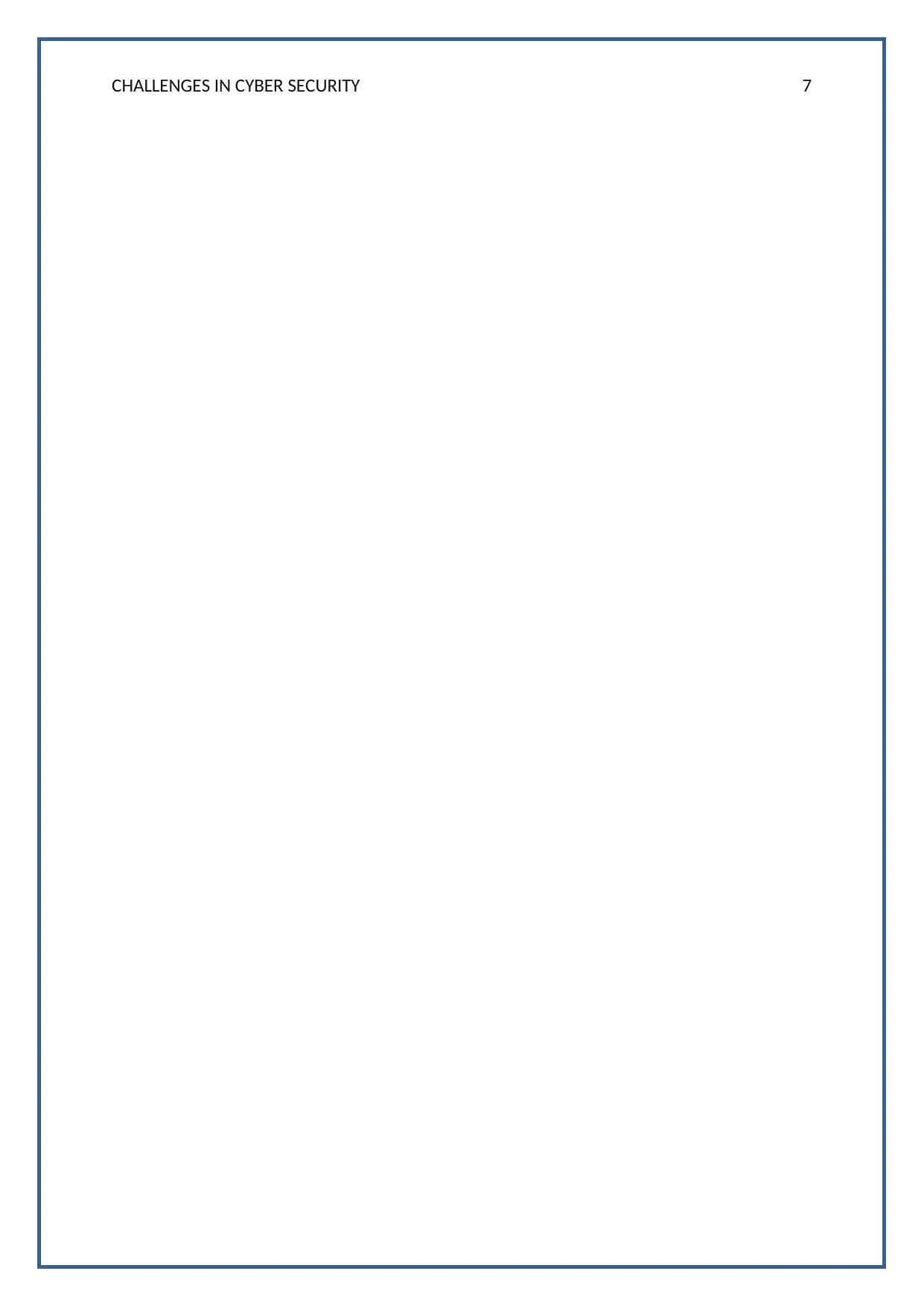
CHALLENGES IN CYBER SECURITY 7
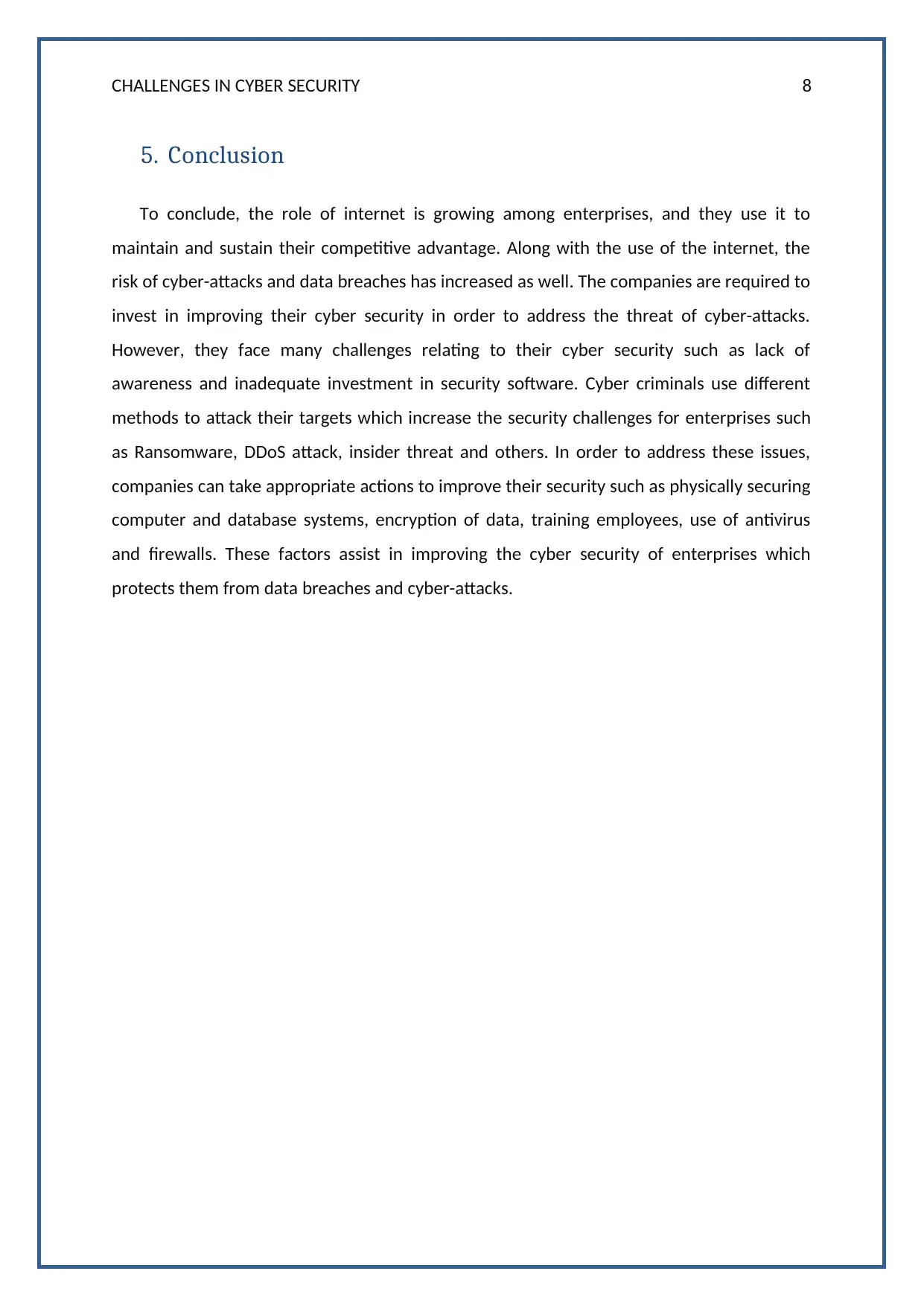
CHALLENGES IN CYBER SECURITY 8
5. Conclusion
To conclude, the role of internet is growing among enterprises, and they use it to
maintain and sustain their competitive advantage. Along with the use of the internet, the
risk of cyber-attacks and data breaches has increased as well. The companies are required to
invest in improving their cyber security in order to address the threat of cyber-attacks.
However, they face many challenges relating to their cyber security such as lack of
awareness and inadequate investment in security software. Cyber criminals use different
methods to attack their targets which increase the security challenges for enterprises such
as Ransomware, DDoS attack, insider threat and others. In order to address these issues,
companies can take appropriate actions to improve their security such as physically securing
computer and database systems, encryption of data, training employees, use of antivirus
and firewalls. These factors assist in improving the cyber security of enterprises which
protects them from data breaches and cyber-attacks.
5. Conclusion
To conclude, the role of internet is growing among enterprises, and they use it to
maintain and sustain their competitive advantage. Along with the use of the internet, the
risk of cyber-attacks and data breaches has increased as well. The companies are required to
invest in improving their cyber security in order to address the threat of cyber-attacks.
However, they face many challenges relating to their cyber security such as lack of
awareness and inadequate investment in security software. Cyber criminals use different
methods to attack their targets which increase the security challenges for enterprises such
as Ransomware, DDoS attack, insider threat and others. In order to address these issues,
companies can take appropriate actions to improve their security such as physically securing
computer and database systems, encryption of data, training employees, use of antivirus
and firewalls. These factors assist in improving the cyber security of enterprises which
protects them from data breaches and cyber-attacks.
⊘ This is a preview!⊘
Do you want full access?
Subscribe today to unlock all pages.

Trusted by 1+ million students worldwide
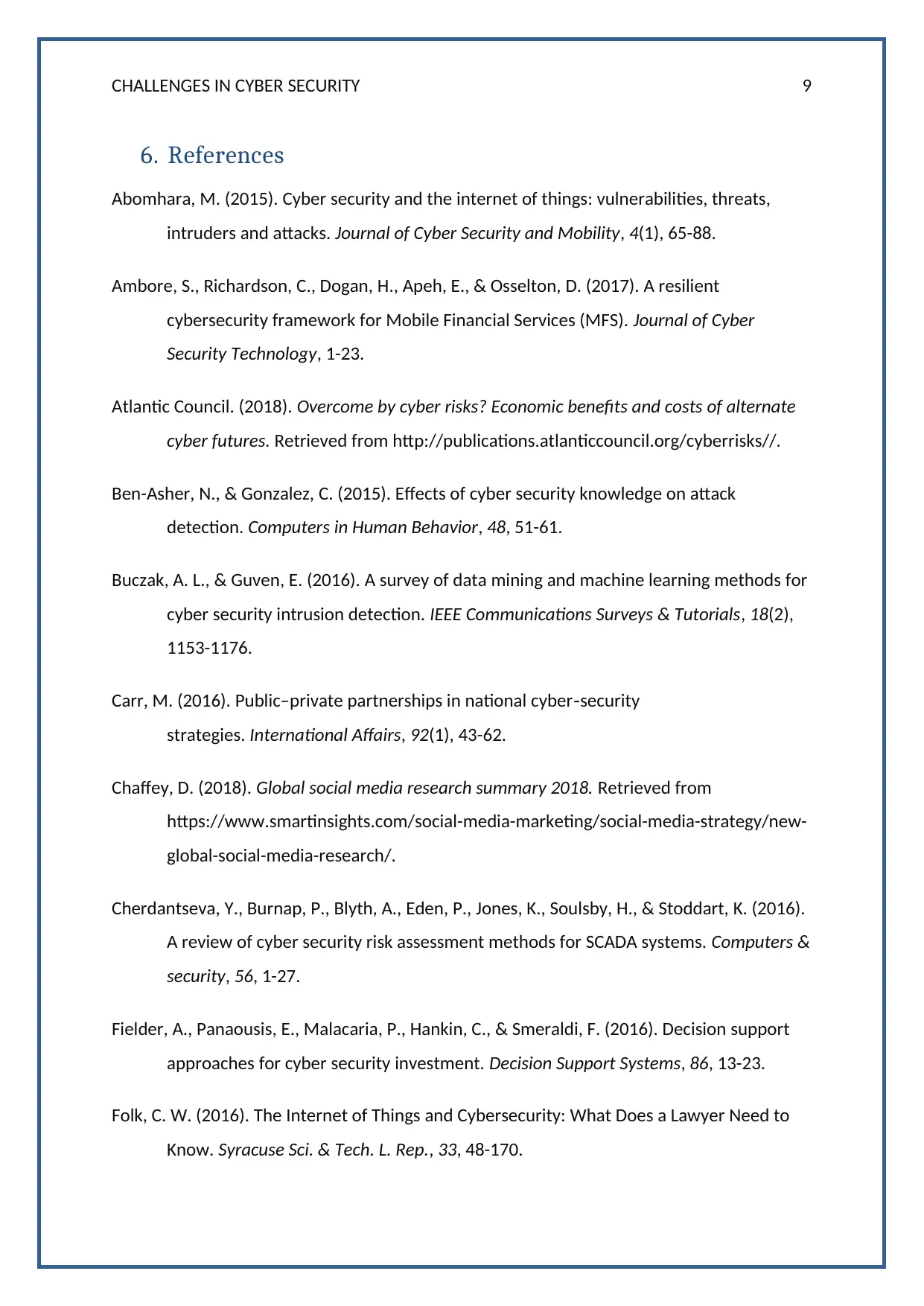
CHALLENGES IN CYBER SECURITY 9
6. References
Abomhara, M. (2015). Cyber security and the internet of things: vulnerabilities, threats,
intruders and attacks. Journal of Cyber Security and Mobility, 4(1), 65-88.
Ambore, S., Richardson, C., Dogan, H., Apeh, E., & Osselton, D. (2017). A resilient
cybersecurity framework for Mobile Financial Services (MFS). Journal of Cyber
Security Technology, 1-23.
Atlantic Council. (2018). Overcome by cyber risks? Economic benefits and costs of alternate
cyber futures. Retrieved from http://publications.atlanticcouncil.org/cyberrisks//.
Ben-Asher, N., & Gonzalez, C. (2015). Effects of cyber security knowledge on attack
detection. Computers in Human Behavior, 48, 51-61.
Buczak, A. L., & Guven, E. (2016). A survey of data mining and machine learning methods for
cyber security intrusion detection. IEEE Communications Surveys & Tutorials, 18(2),
1153-1176.
Carr, M. (2016). Public–private partnerships in national cyber‐security
strategies. International Affairs, 92(1), 43-62.
Chaffey, D. (2018). Global social media research summary 2018. Retrieved from
https://www.smartinsights.com/social-media-marketing/social-media-strategy/new-
global-social-media-research/.
Cherdantseva, Y., Burnap, P., Blyth, A., Eden, P., Jones, K., Soulsby, H., & Stoddart, K. (2016).
A review of cyber security risk assessment methods for SCADA systems. Computers &
security, 56, 1-27.
Fielder, A., Panaousis, E., Malacaria, P., Hankin, C., & Smeraldi, F. (2016). Decision support
approaches for cyber security investment. Decision Support Systems, 86, 13-23.
Folk, C. W. (2016). The Internet of Things and Cybersecurity: What Does a Lawyer Need to
Know. Syracuse Sci. & Tech. L. Rep., 33, 48-170.
6. References
Abomhara, M. (2015). Cyber security and the internet of things: vulnerabilities, threats,
intruders and attacks. Journal of Cyber Security and Mobility, 4(1), 65-88.
Ambore, S., Richardson, C., Dogan, H., Apeh, E., & Osselton, D. (2017). A resilient
cybersecurity framework for Mobile Financial Services (MFS). Journal of Cyber
Security Technology, 1-23.
Atlantic Council. (2018). Overcome by cyber risks? Economic benefits and costs of alternate
cyber futures. Retrieved from http://publications.atlanticcouncil.org/cyberrisks//.
Ben-Asher, N., & Gonzalez, C. (2015). Effects of cyber security knowledge on attack
detection. Computers in Human Behavior, 48, 51-61.
Buczak, A. L., & Guven, E. (2016). A survey of data mining and machine learning methods for
cyber security intrusion detection. IEEE Communications Surveys & Tutorials, 18(2),
1153-1176.
Carr, M. (2016). Public–private partnerships in national cyber‐security
strategies. International Affairs, 92(1), 43-62.
Chaffey, D. (2018). Global social media research summary 2018. Retrieved from
https://www.smartinsights.com/social-media-marketing/social-media-strategy/new-
global-social-media-research/.
Cherdantseva, Y., Burnap, P., Blyth, A., Eden, P., Jones, K., Soulsby, H., & Stoddart, K. (2016).
A review of cyber security risk assessment methods for SCADA systems. Computers &
security, 56, 1-27.
Fielder, A., Panaousis, E., Malacaria, P., Hankin, C., & Smeraldi, F. (2016). Decision support
approaches for cyber security investment. Decision Support Systems, 86, 13-23.
Folk, C. W. (2016). The Internet of Things and Cybersecurity: What Does a Lawyer Need to
Know. Syracuse Sci. & Tech. L. Rep., 33, 48-170.
Paraphrase This Document
Need a fresh take? Get an instant paraphrase of this document with our AI Paraphraser
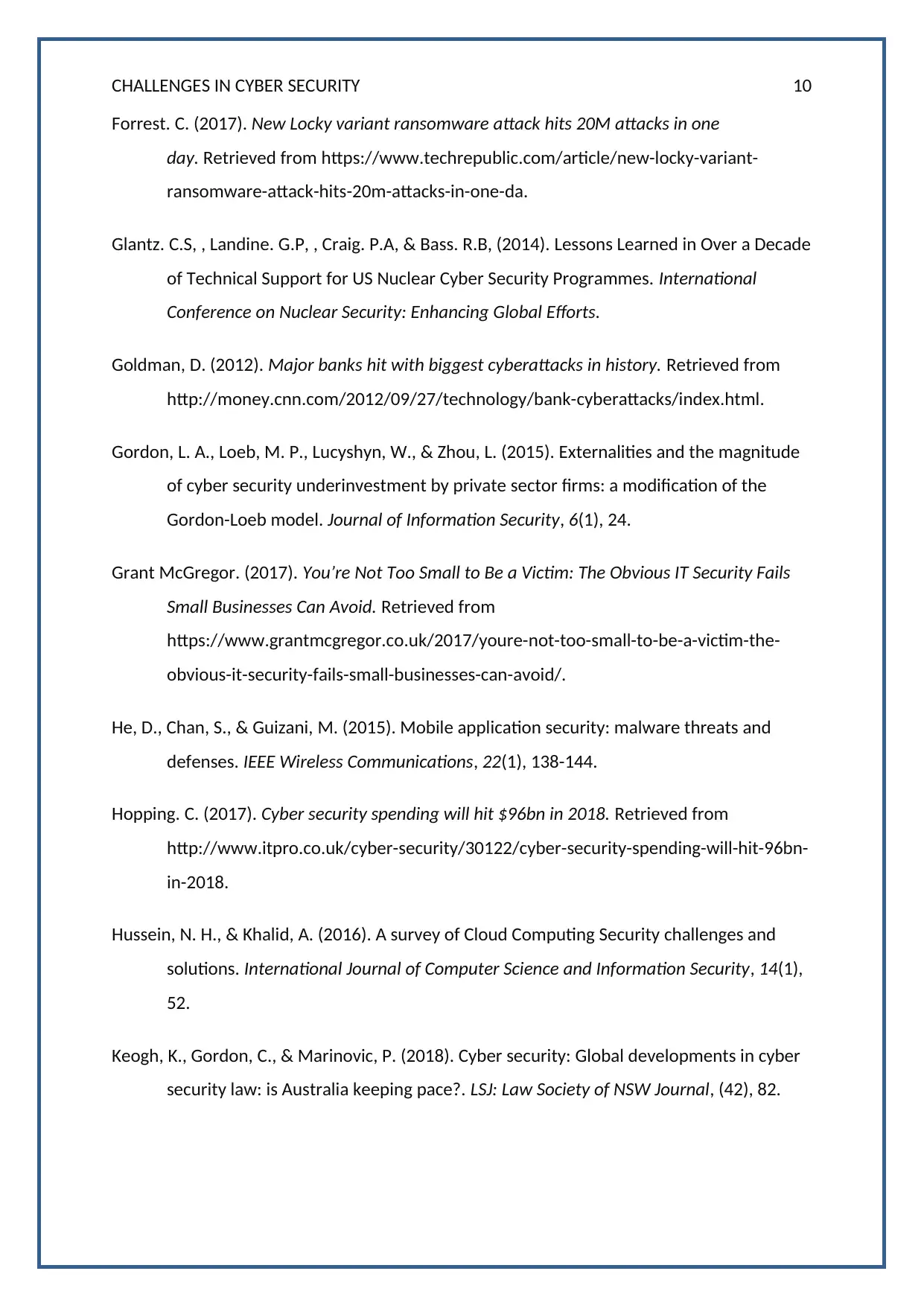
CHALLENGES IN CYBER SECURITY 10
Forrest. C. (2017). New Locky variant ransomware attack hits 20M attacks in one
day. Retrieved from https://www.techrepublic.com/article/new-locky-variant-
ransomware-attack-hits-20m-attacks-in-one-da.
Glantz. C.S, , Landine. G.P, , Craig. P.A, & Bass. R.B, (2014). Lessons Learned in Over a Decade
of Technical Support for US Nuclear Cyber Security Programmes. International
Conference on Nuclear Security: Enhancing Global Efforts.
Goldman, D. (2012). Major banks hit with biggest cyberattacks in history. Retrieved from
http://money.cnn.com/2012/09/27/technology/bank-cyberattacks/index.html.
Gordon, L. A., Loeb, M. P., Lucyshyn, W., & Zhou, L. (2015). Externalities and the magnitude
of cyber security underinvestment by private sector firms: a modification of the
Gordon-Loeb model. Journal of Information Security, 6(1), 24.
Grant McGregor. (2017). You’re Not Too Small to Be a Victim: The Obvious IT Security Fails
Small Businesses Can Avoid. Retrieved from
https://www.grantmcgregor.co.uk/2017/youre-not-too-small-to-be-a-victim-the-
obvious-it-security-fails-small-businesses-can-avoid/.
He, D., Chan, S., & Guizani, M. (2015). Mobile application security: malware threats and
defenses. IEEE Wireless Communications, 22(1), 138-144.
Hopping. C. (2017). Cyber security spending will hit $96bn in 2018. Retrieved from
http://www.itpro.co.uk/cyber-security/30122/cyber-security-spending-will-hit-96bn-
in-2018.
Hussein, N. H., & Khalid, A. (2016). A survey of Cloud Computing Security challenges and
solutions. International Journal of Computer Science and Information Security, 14(1),
52.
Keogh, K., Gordon, C., & Marinovic, P. (2018). Cyber security: Global developments in cyber
security law: is Australia keeping pace?. LSJ: Law Society of NSW Journal, (42), 82.
Forrest. C. (2017). New Locky variant ransomware attack hits 20M attacks in one
day. Retrieved from https://www.techrepublic.com/article/new-locky-variant-
ransomware-attack-hits-20m-attacks-in-one-da.
Glantz. C.S, , Landine. G.P, , Craig. P.A, & Bass. R.B, (2014). Lessons Learned in Over a Decade
of Technical Support for US Nuclear Cyber Security Programmes. International
Conference on Nuclear Security: Enhancing Global Efforts.
Goldman, D. (2012). Major banks hit with biggest cyberattacks in history. Retrieved from
http://money.cnn.com/2012/09/27/technology/bank-cyberattacks/index.html.
Gordon, L. A., Loeb, M. P., Lucyshyn, W., & Zhou, L. (2015). Externalities and the magnitude
of cyber security underinvestment by private sector firms: a modification of the
Gordon-Loeb model. Journal of Information Security, 6(1), 24.
Grant McGregor. (2017). You’re Not Too Small to Be a Victim: The Obvious IT Security Fails
Small Businesses Can Avoid. Retrieved from
https://www.grantmcgregor.co.uk/2017/youre-not-too-small-to-be-a-victim-the-
obvious-it-security-fails-small-businesses-can-avoid/.
He, D., Chan, S., & Guizani, M. (2015). Mobile application security: malware threats and
defenses. IEEE Wireless Communications, 22(1), 138-144.
Hopping. C. (2017). Cyber security spending will hit $96bn in 2018. Retrieved from
http://www.itpro.co.uk/cyber-security/30122/cyber-security-spending-will-hit-96bn-
in-2018.
Hussein, N. H., & Khalid, A. (2016). A survey of Cloud Computing Security challenges and
solutions. International Journal of Computer Science and Information Security, 14(1),
52.
Keogh, K., Gordon, C., & Marinovic, P. (2018). Cyber security: Global developments in cyber
security law: is Australia keeping pace?. LSJ: Law Society of NSW Journal, (42), 82.
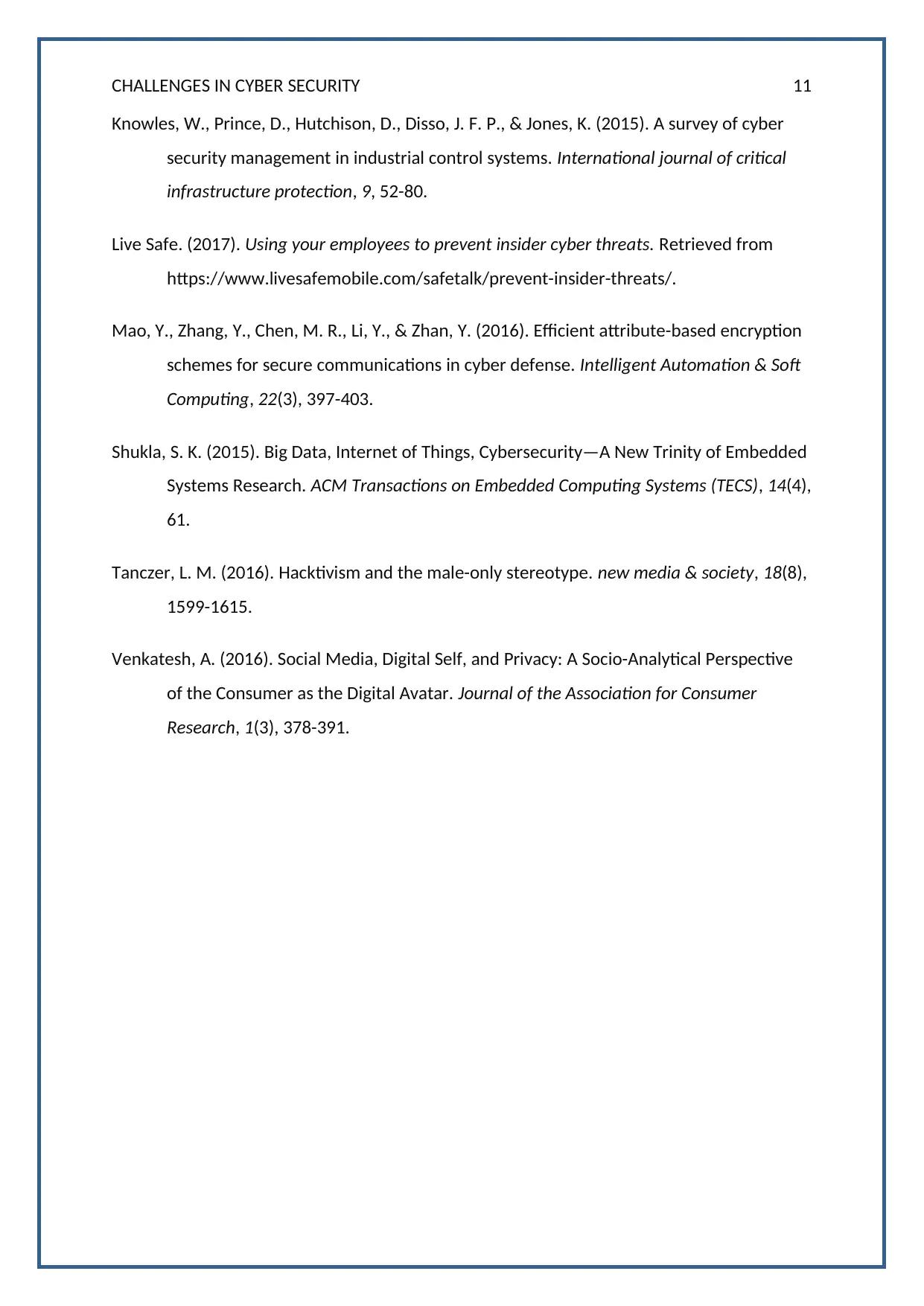
CHALLENGES IN CYBER SECURITY 11
Knowles, W., Prince, D., Hutchison, D., Disso, J. F. P., & Jones, K. (2015). A survey of cyber
security management in industrial control systems. International journal of critical
infrastructure protection, 9, 52-80.
Live Safe. (2017). Using your employees to prevent insider cyber threats. Retrieved from
https://www.livesafemobile.com/safetalk/prevent-insider-threats/.
Mao, Y., Zhang, Y., Chen, M. R., Li, Y., & Zhan, Y. (2016). Efficient attribute-based encryption
schemes for secure communications in cyber defense. Intelligent Automation & Soft
Computing, 22(3), 397-403.
Shukla, S. K. (2015). Big Data, Internet of Things, Cybersecurity—A New Trinity of Embedded
Systems Research. ACM Transactions on Embedded Computing Systems (TECS), 14(4),
61.
Tanczer, L. M. (2016). Hacktivism and the male-only stereotype. new media & society, 18(8),
1599-1615.
Venkatesh, A. (2016). Social Media, Digital Self, and Privacy: A Socio-Analytical Perspective
of the Consumer as the Digital Avatar. Journal of the Association for Consumer
Research, 1(3), 378-391.
Knowles, W., Prince, D., Hutchison, D., Disso, J. F. P., & Jones, K. (2015). A survey of cyber
security management in industrial control systems. International journal of critical
infrastructure protection, 9, 52-80.
Live Safe. (2017). Using your employees to prevent insider cyber threats. Retrieved from
https://www.livesafemobile.com/safetalk/prevent-insider-threats/.
Mao, Y., Zhang, Y., Chen, M. R., Li, Y., & Zhan, Y. (2016). Efficient attribute-based encryption
schemes for secure communications in cyber defense. Intelligent Automation & Soft
Computing, 22(3), 397-403.
Shukla, S. K. (2015). Big Data, Internet of Things, Cybersecurity—A New Trinity of Embedded
Systems Research. ACM Transactions on Embedded Computing Systems (TECS), 14(4),
61.
Tanczer, L. M. (2016). Hacktivism and the male-only stereotype. new media & society, 18(8),
1599-1615.
Venkatesh, A. (2016). Social Media, Digital Self, and Privacy: A Socio-Analytical Perspective
of the Consumer as the Digital Avatar. Journal of the Association for Consumer
Research, 1(3), 378-391.
⊘ This is a preview!⊘
Do you want full access?
Subscribe today to unlock all pages.

Trusted by 1+ million students worldwide
1 out of 14
Related Documents
Your All-in-One AI-Powered Toolkit for Academic Success.
+13062052269
info@desklib.com
Available 24*7 on WhatsApp / Email
![[object Object]](/_next/static/media/star-bottom.7253800d.svg)
Unlock your academic potential
Copyright © 2020–2025 A2Z Services. All Rights Reserved. Developed and managed by ZUCOL.





